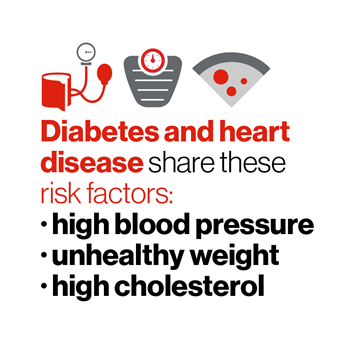What is diabetes?
Diabetes is a life-long condition where your body does not produce enough insulin (Type 1) or your body cannot use the insulin it has effectively (Type 2).
Your body uses insulin to break down and control how much sugar is in your blood. Sugar (glucose) is a major source of energy for the cells in your tissue, muscles, heart and brain. If your body is unable to break down the sugar it needs for energy, you will have too much glucose and that can damage organs and blood vessels.
Heart disease, stroke and diabetes
Diabetes increases the risk of high blood pressure, narrowing of the arteries (atherosclerosis), coronary artery disease and stroke. So if you are a person with diabetes, you have a higher risk of developing heart disease and stroke.

You are also at risk of developing them at an earlier age. Women with diabetes have an even greater risk for heart disease.

Types of diabetes
- Type 1 diabetes usually develops during childhood, but it can also develop in adults. It happens when the immune system kills beta cells in the pancreas. Beta cells release a hormone, amylin, which controls the rate that glucose releases into your blood. Only 10% of people with diabetes have type 1.
It is unclear what causes type 1 diabetes. What is known is that your immune system attacks cells in your pancreas. There is thought to be a link between diabetes, genetics and environmental factors.
- Type 2 diabetes develops more often in adults, but children can be affected as well. It occurs when the body does not produce enough insulin or cannot use the insulin it does produce. It is the most common type of diabetes.
There is a strong link between being overweight and type 2 diabetes. Genetic and environmental factors may also play a role.
- Gestational diabetes is a temporary condition where your body cannot properly use insulin during pregnancy. During pregnancy, the placenta produces hormones that can make your cells more resistant to insulin. Usually your pancreas produces extra insulin to overcome this, but sometimes it cannot keep up which causes gestational diabetes.
Having gestational diabetes increases the risk of the mother and child developing diabetes later in life.


- Prediabetes means your blood sugar levels are high, but not high enough to be classified as type 2 diabetes. If you have prediabetes your risk for heart disease and other conditions related to diabetes can begin to climb.
Who is at risk?
Having a family member with diabetes puts you at risk for both types. If you have diabetes, encourage your family members to get tested.

Risk factors for type 1
The definite risk factors for type 1 diabetes are not known. But having a family member with type 1 diabetes increases your risk for developing it.
Risk factors for type 2
There are several risk factors for type 2 diabetes. Many of these are also risk factors for heart disease, stroke and other chronic conditions. They include:
- Family history — having a family member with type 2 diabetes increases your risk.
- Weight — your risk could increase if you are overweight or you carry a lot of weight around your stomach.
- Heritage — African, Asian and Hispanic peoples are at a higher risk of developing diabetes.
- Low-income — experiencing food insecurity may also put you at risk for type 2 diabetes.
- High-blood pressure
- High cholesterol
- Gestational diabetes — a large percentage of women who have had gestational diabetes will go on to develop type 2 diabetes.
- Prediabetes — having prediabetes is a major risk factor for developing type 2 diabetes.
- Medical conditions — the following conditions can increase your risk for type 2 diabetes:
- polycystic ovary syndrome
- psychiatric disorders (depression, bipolar disorder, schizophrenia)
- obstructive sleep apnea
- Indigenous populations – due to social, systemic and institutional barriers, Indigenous people are at a higher risk for diabetes. Diabetes Canada offers Just the Basics to help Indigenous populations make healthy choices. This resource is available in English, Inuktitut, Objibwe, Inuinnaqtun, Plains Cree and French.
Symptoms
Symptoms for type 1 diabetes usually develop suddenly and quickly. Type 2 symptoms develop more slowly. If you have type 2 diabetes, you may not have any symptoms at all.
Signs and symptoms of diabetes could include:
- unusual thirst
- frequent urination
- weight change (gain or loss)
- extreme fatigue or lack of energy
- blurred vision
- frequent or recurring infections
- cuts and bruises that are slow to heal
- tingling or numbness in the hands or feet
- trouble getting or maintaining an erection
Diagnosis
Your doctor will diagnose diabetes after reviewing your symptoms, taking a medical history and giving you a complete physical exam.
Tests will be done to measure glucose levels in your blood. The A1C test measures glucose and reflects your average blood sugar levels over the past 2-3 months. If the A1C test is not available or you are unable to take this test for any reason (like pregnancy), you may be asked to take one of the following tests:
- fasting blood glucose
- random blood glucose
- oral glucose tolerance
Treatment
Managing your diabetes is important to prevent heart disease and stroke. Treatment for diabetes may include medication and lifestyle changes. You and your doctor will discuss the treatment options and decide which is best for you.
Insulin Insulin therapy is required for the treatment of type 1 diabetes. Your doctor will help you to understand the dosage, timing and number of injections you might need.
People living with type 2 diabetes may also need insulin. The key to managing type 2 diabetes is monitoring and maintaining your blood sugar levels in the target range set by you and your healthcare provider.
Controlling blood sugar through healthy lifestyle choices Controlling your blood sugar level is crucial to your health (and your baby’s health if you have gestational diabetes). Healthy lifestyle choices can help bring your blood sugar level back to normal or keep it from rising. The good news is that the lifestyle changes you need to make are the same choices that will help you to lower your risk of heart disease, stroke and other medical conditions. Find more information on how to get healthy.
Controlling blood sugar with medication There are several oral medications to treat type 2 diabetes that work in different ways to control blood sugar by increasing insulin production, making you more sensitive to insulin or slowing digestion. You might also need medications to control your cholesterol and high blood pressure. Learn more about medications that can protect you from heart disease and stroke.
Living with diabetes
Here are the ABCDESSS of living with diabetes. Follow these basic steps to protect your health:
A: A1C. Monitor and control your blood sugar levels.
B: Blood pressure. Know your blood pressure and take steps to keep it in a healthy range.
C: Cholesterol. Make sure your LDL cholesterol levels are low.
D: Drugs to decrease heart disease risk. This might include blood pressure pills, cholesterol-lowering pills and others.
E: Exercise and healthy eating.
S: Self-management support. Set goals to reach and maintain a healthy lifestyle and understand what stands in your way.
S: Screening or monitoring for complications. Be sure to check in with your doctor about the health of your heart, feet, kidneys, and eyes.
S: Stop smoking.
Related information
- Learn about the risk factors for heart disease and stroke.
- Visit Diabetes Canada for more information about diabetes and cardiovascular protection in people with diabetes.
- Use HeartHub’s research guide to learn more about the treatment options for coronary artery disease and diabetes.
